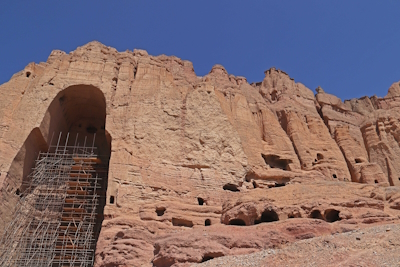Bamiyan Valley

The Cultural Landscape and Archaeological Remains of the Bamiyan Valley is an outstanding representation of Gandharan Buddhist art and culture in Central Asia.
The kingdom of Bamiyan was a Buddhist state strategically located on the Silk Road and an important pilgrimage center. The site has eight components, including caves with painted decorations and Buddha statues carved into the cliffs. The cliffs held two standing Buddhas, measuring 55 and 37 meters high respectively, that were the largest examples of standing Buddha carvings in the world. They were deliberately destructed in March 2001 by the Afghan Taliban government and only the niches remain.
Community Perspective: Sidney visited in 1971 and witnessed a spectacular sunset on the Buddha statues. Wojciech has described the situation he found in 2024, when he saw the now empty niches and two further components.


Map of Bamiyan Valley
Community Reviews
Wojciech Fedoruk

I visited the monuments of Bamyan during one day in September 2024. For an appetizer, there was Shahr-i Ghulghulah, which can be translated as the City of Screams. This rather terrifying name comes from the destruction of the city by Genghis Khan's troops, which left no one alive. Apparently this was because Genghis Khan's beloved grandson had been killed earlier during the siege of Bamyan, but the Mongols did not need too many excuses to destroy everything living among their defeated opponents. The City of Screams never recovered from this massacre and today it is a complex of charming ruins on the mountainside.
The main course was something that doesn't exist. The world's largest standing Buddha statues, carved into rocks in the 6th century AD. and barbarously destroyed by the Taliban during their first rule in 2001. Despite several attempts and the scaffolding existing for unknown reasons, these statues have not been recreated, only niches remain. They can be viewed from below and above, because a system of corridors led to the head of each statue. Currently, the corridors located next to the smaller, 37-meter statue are open. Visiting the niches is more of an exercise in the imagination, because without the statues they are much less interesting. As a side note - it seems that the current Taliban are more liberal for now, but in my opinion this is just an illusion. After consolidating their power, they may return to the barbaric practices known from 1996-2001.
Probably the most interesting monument of Bamyan was Shahr-i-Zuhak, located several kilometers away. Zuhak was built in the 6th century, fortified several hundred years later, and destroyed during the same Mongol invasion that destroyed the City of Screams. The city was divided into two parts - residential and defensive. There are steep stairs leading to the living area - the climb takes about 20 minutes and is very tiring. It takes at least another 20 minutes to get to the defensive part. Some of our group gave up on the second part, which is a pity - there are fantastic views from the top. At the top there is a Soviet cannon, probably transported there by helicopter. Zuhak is ruined, but some of the richly decorated walls have survived to this day and are extremely spectacular.
sidney
It was not exactly a day more like a 2 week experience in 1971. The most amazing place on my journey East. I had the good fortune to sit on the Giant Buddhas head and meditate and watch the sun rise over the Hindu Kush and watch those mountain peaks turn a color red that I had never seen in my life. The sunset on the buddha was just as spectacular. Lost to us forever by forces from hell. I also had the good fortune to ride horses over the fiords of Band I Amir lakes. I will never forget my trip to Bamiyan, I cried when I saw the destruction of the Buddha, I cried for all our loss but most of all for Hazra people who no longer have the magic of the Buddha. Sidney
Community Rating
Site Info
- Full Name
- Cultural Landscape and Archaeological Remains of the Bamiyan Valley
- Unesco ID
- 208
- Country
- Afghanistan
- Inscribed
-
2003 - In Danger
- Type
- Cultural
- Criteria
-
1 2 3 4 6
- Categories
- Cultural Landscape - Relict Religious structure - Buddhist
- Link
- By ID
Site History
2003 In Danger
"suffered from abandonment, military action and dynamite explosions. Parts of the site are inaccessible due to the presence of antipersonnel mines."
2003 Inscribed
1983 Deferred
Deferred as conditions under which recommendation made not yet fulfilled
Site Links
Unesco Website
Official Website
Related
In the News
Locations
The site has 8 locations
Connections
The site has 33 connections
Art and Architecture
Constructions
Damaged
Geography
History
Individual People
Religion and Belief
Science and Technology
Timeline
Trivia
Visiting conditions
WHS Names
WHS on Other Lists
World Heritage Process
Visitors
19 Community Members have visited.
The Plaque
No plaque has been identified yet for this site.